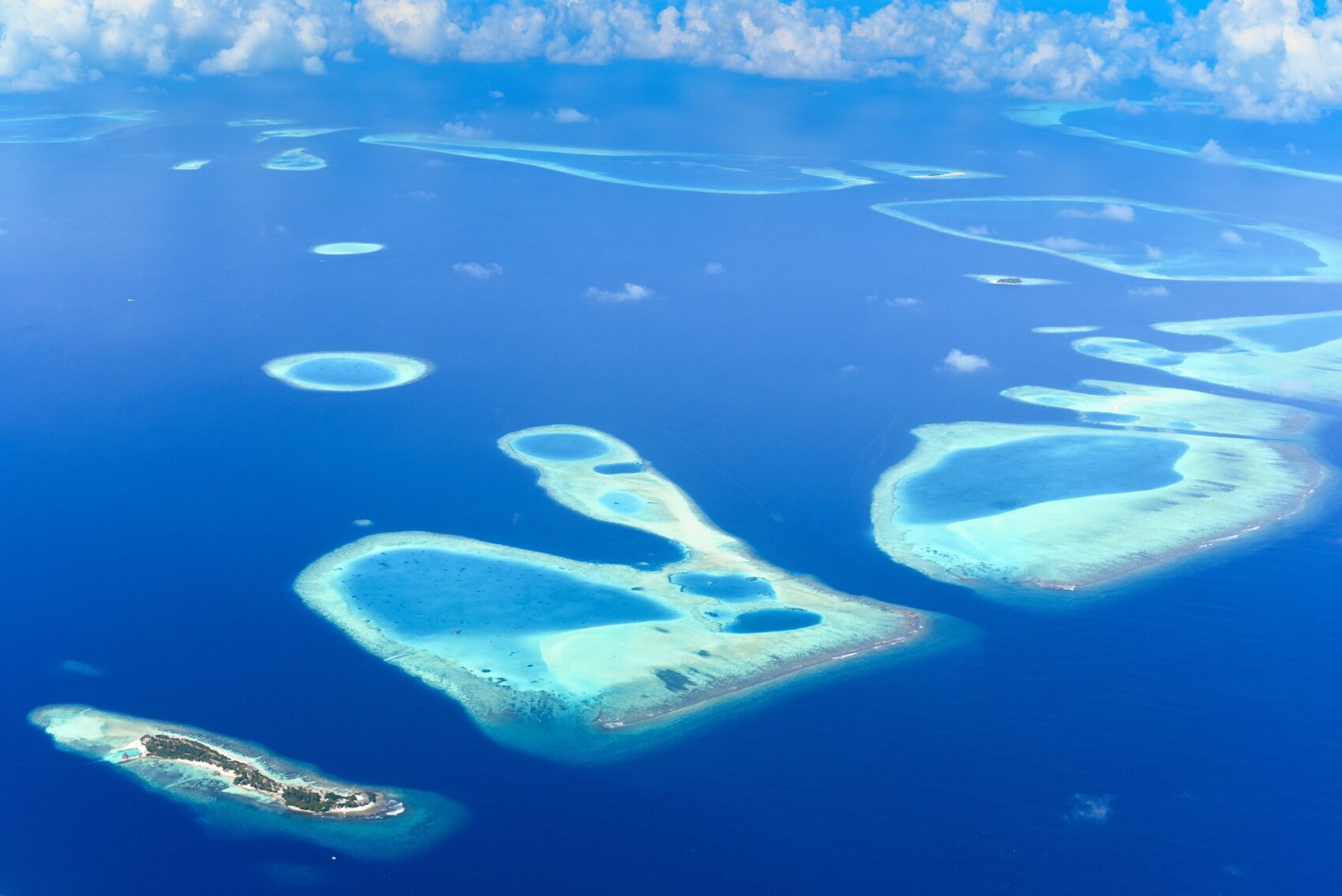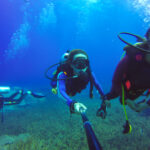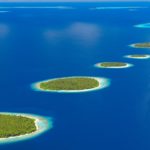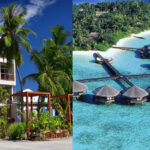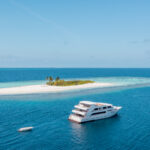In the vast expanse of the Indian Ocean, the Maldives is an archipelago of dreams, where white sand beaches merge into turquoise waters. Each of its 1190 coral islands serves as a sanctuary, offering a serene escape from the bustling world beyond its shores.

Rich in a blend of influences from East Africa, the Arabian Peninsula, and the Indian subcontinent, the Maldives is more than just a tropical paradise; it’s a culturally rich nation with deep-rooted traditions and an intrinsic connection to the sea.
As one of the world’s lowest-lying country (just 1.5 m above sea level), it stands at the forefront of climate challenges, making sustainability a key focus of both its community initiatives, fishing industry and its booming tourism sector, which breathes life into its economy and sustains its ancient, ocean-centric way of life.
This article explore the Maldives. Learn about its rich culture, unique language, and vibrant arts scene, as well as its stunning coral reefs and marine life. Discover how this low-lying nation is tackling environmental challenges and shaping a sustainable future.
In the vast expanse of the Indian Ocean, the Maldives is an archipelago of dreams, where white sand beaches merge into turquoise waters. Each of its 1190 coral islands serves as a sanctuary, offering a serene escape from the bustling world beyond its shores.
Rich in a blend of influences from East Africa, the Arabian Peninsula, and the Indian subcontinent, the Maldives is more than just a tropical paradise; it’s a culturally rich nation with deep-rooted traditions and an intrinsic connection to the sea.
As one of the world’s lowest-lying country (just 1.5 m above sea level), it stands at the forefront of climate challenges, making sustainability a key focus of both its community initiatives, fishing industry and its booming tourism sector, which breathes life into its economy and sustains its ancient, ocean-centric way of life.
This article explores the Maldives. Learn about its rich culture, unique language, and vibrant arts scene, as well as its stunning coral reefs and marine life. Discover how this low-lying nation is tackling environmental challenges and shaping a sustainable future.
Culture, People, and Language of the Maldives
Culture of Hospitality
Beyond Maldives natural beauty, lies a special gem – the unyielding Maldivian hospitality. For over 50 years, travelers have been drawn to this dream destination, and it’s the warm welcome that keeps them coming back.
Maldivians understand the importance of community and hospitality, living on small islands surrounded by the vast ocean. From airport smiles to resort welcomes with traditional boduberu music and refreshing drinks, you’ll feel the warmth and friendliness inherent in our culture.
Whether you stay in a luxury resort, cozy guesthouse, liveaboard, or hotel, you’ll experience the genuine Maldivian hospitality that makes this destination truly special. Come and discover the magic of the Maldives!
A Rich History
The Maldives has a rich and vibrant history that’s full of fascinating stories and legends. From as far back as 2500 BC, the islands have been visited by various cultures, including the Phoenicians, Egyptians, and Mesopotamians, who all left their mark on the archipelago.
One of the most interesting facts about the Maldives is that cowry shells were once used as currency! These shells were highly valued across the world and have even been found in ancient ruins like Lothal, a port city in the Indus Valley dating back to 1400 BC.
Despite its long history, the Maldives remains somewhat of an enigma, with much of its ancient past still unknown. Maldivians with its unique culture and traditions shaped by its geographic location and the many different cultures that have interacted with the islands over the centuries.
Today, the Maldives is home to just over half a million people, but it has a distinct culture and language all its own. The Dhivehi language is an Indo-Aryan tongue with roots in Sanskrit, and the Maldivian people have developed a unique script called Thaana.
The Maldives’ history and culture are a true melting pot of influences from around the Indian Ocean, shaped by the island environment and the surrounding seas. From its vibrant traditions to its stunning natural beauty, the Maldives is a truly special place to visit and experience.
Folklore
The Maldives is rich in legends and folklore that are integral to its cultural heritage. Stories of key historical events, such as the arrival of the first settlers, the conversion to Islam, and the liberation from Portuguese rule, have been preserved through oral traditions. One of the most beloved tales is that of Dhon Hiyala and Ali Fulhu, a love story set in the 14th century that illustrates the Maldivians’ close relationship with the sea and their resilience against external threats.
The story of Rannamaari, a sea demon that terrorized Male’ until the arrival of Abu al-Barakaath Yusuf al-Barbari, a Moroccan traveler, underscores the dramatic shift from idol worship to Islam in 1153 AD. This conversion story is marked by the courage of al-Barbari, who intervened to stop the sacrifice of a virgin girl to the demon, ultimately leading to the island’s conversion to Islam. Ibn Batuta, the renowned traveler and historian, documented this legend during his stay in the 14th century, noting how deeply these myths were ingrained in the Maldivian psyche.
European and South Asian Influence
By the mid-16th century, the Maldives experienced European intervention when it was invaded by the Portuguese in 1558, who ruled until 1573. Following this period, continuous raids by the Malabars from South West India during the 17th and 18th centuries significantly impacted the islands.
The local Sultans sought protection from foreign powers, first approaching the French and later signing a protectorate agreement with the British in 1887.
Navigational and Diplomatic Chronicles
Historical records of the Maldives have been discovered globally, from Roman times to the Tang dynasty in China. This includes accounts like the Roman navigation manual, Periplus Maris Erithraei, and mentions by the 2nd-century Greek geographer Ptolemy.
Additionally, notable visits such as the delegation of Divis (Maldivians) to Rome in 362 AD, and the sending of gifts to the Chinese Emperor in 658 AD and 662 AD, highlight the extensive international reach and diplomatic activities of the Maldives throughout history.
Cultural and Religious Shifts
The religious landscape of the Maldives was profoundly altered with the arrival of Buddhism and later, Islam. These shifts are documented in ancient chronicles such as the Mahavansa of Sri Lanka, which links the Maldives to significant regional historical events.
The culture of the Maldives reflects a rich mosaic of influences shaped by its strategic location along ancient maritime trade routes. The predominant influence is from South Asia, but layers of Arabic, African, and Southeast Asian elements are evident due to centuries of trade and exchange.
Since the 12th century, Islam has played a central role in shaping Maldivian society, evident in the country’s art, architecture, and social norms.
The Maldivian People
Evidence suggests that the Maldives has been populated and thriving as early as the 4th century BC. The first settlers were likely an Indo-Aryan race from India, with historical records also noting migration from Arabia and eastern Africa.
An anthropological survey conducted at the end of the 19th century indicated that Maldivians possessed traits linking them ancestrally with peoples from all corners of the Indian Ocean. Today, Maldivians form a mixed race, with a population of about 550,000.

Travelers have often remarked on the kindness and hospitality of the Maldivian people, describing them as peaceable and welcoming to visitors. Despite the geographic dispersion of the islands over a vast stretch of ocean, a common history, faith, and language unify the Maldivian people, maintaining national cohesion for centuries.
Dhivehi: The Heartbeat of Maldivian Identity
The Dhivehi language, an Indo-Aryan language, is the official language spoken across all atolls. Dhivehi has evolved significantly through contact with the outside world, absorbing influences and incorporating words from Arabic, Hindi, and English. Historically, the early Maldivian people spoke “Elu,” a form of ancient Sinhalese, and many Dhivehi words have roots in Sanskrit.
Dhivehi remains a crucial element of Maldivian identity, used in administration and as a compulsory subject in the national curriculum. While English is widely understood and spoken, many in the tourist industry are also fluent in other European languages and Japanese.

Dhivehi has its own script, Thaana, which evolved from Arabic numerals and is written from right to left. The language is a crucial element of the Maldivian identity, encapsulating the nation’s history and cultural heritage. It varies slightly from atoll to atoll, with some southern islands having dialects that preserve older linguistic features, reflecting the diverse historical influences that have shaped the language.
Maldivian Dress
The Maldives has its own traditional attire, which has evolved over time. In Male’, the capital, one can see a mixture of traditional and modern clothing styles. The oldest traditional dress is the Libaas, worn with an underskirt known as Feyli.
The Feyli, a dark brown or black wraparound skirt bordered with broad white stripes, has historically been important for both men and women. It was part of the ceremonial dress for palace guards and attendants, and worn by nobility as a sarong.

The Dhigu Hedhun, introduced in the 1950s, has become the national dress for women, worn both daily and at important national functions.
Arts and crafts
The Maldives’ stunning natural beauty and rich Islamic heritage have inspired a vibrant arts scene. Traditional crafts like mat weaving, lacquer work, and boat building are not only beautiful but also essential to the local economy.
The iconic dhoni boat is a symbol of the Maldivians’ deep connection with the sea. With its elegant design and shape, it’s a work of art in itself. Skilled craftsmen still build dhonis using traditional techniques, passed down through generations.
Maldivian artisans are known for their intricate designs and patterns, which adorn everything from mats to lacquered pieces. Their creativity and skill are evident in the beautiful coral carvings and calligraphy that decorate ancient mosques.
Despite modern influences, traditional Maldivian arts and crafts remain largely unchanged, preserving the country’s unique cultural heritage. Visitors can experience this rich cultural scene firsthand, exploring local markets and workshops to discover the beauty of Maldivian artistry.
Culinary Expressions
Maldivian cuisine is a delicious blend of three main ingredients: fish, coconut, and starches like rice and flatbread. Fresh tuna is a staple, with dishes like masroshi and garudhiya (fish broth) being local favorites. The country’s oceanic surroundings and cultural exchange with travelers and traders have shaped its unique culinary tradition.
Maldivian dishes have a familiar flavor profile with East Asian, East African, and Arabian cuisine, with a hint of Indian and Sri Lankan spices. Traditional ingredients like fresh, smoked, and dried tuna, grated coconut, and coconut milk are used in most dishes. You can try local fare at restaurants in Malé and inhabited islands, while resorts offer a range of international cuisine and fine dining options.
From underwater restaurants to romantic moonlight suppers and beach barbecues, the Maldives offers a culinary experience for every visitor. Come and indulge in the country’s fresh seafood, exotic spices, and warm hospitality!
Sustainability in the Maldives
In the Maldives, we’re committed to sustainability in all its forms. While tourism drives our economy, fishing remains a vital source of income for many families. We’re world leaders in sustainable pole-and-line tuna fishing, ensuring a healthy ocean and livelihoods for our communities.
Our tourism sector has embraced sustainability, with luxury resorts, boutique hotels, and guesthouses working together to protect our environment. We’re proud to be a global leader in climate crisis activism, advocating for the protection of Small Island Developing States and vulnerable communities.
To preserve our unique culture and environment, the government has pledged to protect one reef, one mangrove, and one uninhabited island in each atoll. Resorts and tourist establishments offer conservation activities, educating visitors on coral rejuvenation and sustainability. Join us in our mission to preserve the Maldives’ beauty and way of life.
The Underwater Ecosystem
The Maldives is renowned for its extensive coral reefs, which form the backbone of a vibrant underwater ecosystem. These coral reefs are comprised of more than 200 species of coral that build the reef’s structure and provide habitat for an astonishing variety of marine life.
The reefs are not only a key attraction for tourists but also play a crucial role in protecting the islands from wave erosion and support local fishing industries, which are vital to the economy.
Biodiversity and Conservation Efforts
The Maldivian reefs are home to over 2000 species of fish, many species of whales and dolphins, and numerous other marine creatures, including five species of sea turtles.
This high level of biodiversity makes the Maldives one of the most fascinating diving destinations in the world. The conservation of these reefs is critical, as they face threats from coral bleaching caused by rising sea temperatures and other human-induced factors such as overfishing and pollution.
Coral Bleaching and Resilience
Coral bleaching events have significantly impacted the reefs of the Maldives, particularly global bleaching events that occurred in 1998 and 2016.
These events resulted in extensive damage to coral health due to elevated sea temperatures. However, the resilience of coral reefs has been evident through efforts to rejuvenate them, including electrified cones to encourage coral growth, showing promising signs of recovery.
Development
The Maldives has made significant strides in economic development, notably since the 1970s when it opened up to tourism, which has since become the cornerstone of the economy.
The shift from a reliance on fisheries to tourism has transformed the economy, making it one of the fastest-growing in the region.
The Maldives has also shown remarkable progress in human development, including indicators like life expectancy, education, and per capita income. The Maldives has significantly improved in these areas, thanks to robust educational programs and health care reforms.
Key Industries
Tourism not only dominates the economy but also influences other sectors. It has fostered the development of secondary industries like construction, transportation, and services, directly affecting infrastructure growth across the islands.
The fisheries sector remains vital, supporting the livelihoods of many locals and contributing to national exports, mainly through the processing and export of tuna.
Challenges and Adaptations
Despite these successes, the Maldives faces challenges like environmental vulnerability due to climate change. Rising sea levels and coral bleaching threaten its low-lying islands, posing risks to the tourism sector and the overall sustainability of its economic development.
The Maldives has been innovative in response to its geographical and environmental challenges. For example, it has integrated climate-resilient islands and renewable technologies to reduce its reliance on imported diesel for power.
Looking forward, the Maldives will continue to invest in sustainable tourism and infrastructure development, address environmental concerns, and manage external debt to maintain its economic growth and development trajectory.
Overall, the Maldives exemplifies a unique blend of leveraging its natural beauty for economic benefit while navigating the complexities of environmental vulnerabilities and global financial pressures.

